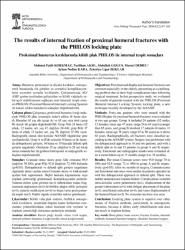| dc.contributor.author | Korkmaz, Mehmet Fatih | |
| dc.contributor.author | Aksu, Neslihan | |
| dc.contributor.author | Göğüş, Abdullah | |
| dc.contributor.author | Debre, Mürsel | |
| dc.contributor.author | Kara, Ayhan Nedim | |
| dc.contributor.author | Işıklar, Zekeriya Uğur | |
| dc.date.accessioned | 2014-12-26T15:07:43Z | |
| dc.date.available | 2014-12-26T15:07:43Z | |
| dc.date.issued | 2008 | |
| dc.identifier.citation | Korkmaz MF, Aksu N, Gogus A, Debre M, Kara AN, Isiklar ZU. [The results of internal fixation of proximal humeral fractures with the PHILOS locking plate]. Acta Orthopaedica et Traumatologica Turcica. 2008; 42(2): 97-105. | en_US |
| dc.identifier.issn | 1017-995X | |
| dc.identifier.uri | http://www.aott.org.tr/article/view/5000010279/5000010262 | en_US |
| dc.identifier.uri | https://hdl.handle.net/11446/624 | en_US |
| dc.description | İstanbul Bilim Üniversitesi, Tıp Fakültesi. | en_US |
| dc.description.abstract | Objectives: Proximal and diaphyseal humeral fractures are common especially in the elderly, presenting as a challenging problem due to their high complication rates following surgical treatment. In this prospective study, we evaluated the results of patients treated with the PHILOS (Proximal Humeral Internal Locking System) locking plate, a new technique recently developed by the AO/ASIF. Methods: Forty-one patients who were treated with the PHILOS plate for proximal humeral fractures were evaluated in two age groups. Group A included 24 patients (12 males, 12 females; mean age 47 years; range 24 to 64 years) younger than 65 years, and group B involved 17 patients (4 males, 13 females; mean age 78 years; range 67 to 90 years) at or above 65 years. Radiographically, all fractures were classified according to the AO/ASIF system. Surgery was performed with the deltopectoral approach in 10 and two patients, and with a deltoid split in 14 and 15 patients in group A and B, respectively. Functional and radiographic results were evaluated after a mean follow-up of 15 months (range 6 to 28 months). Results: The mean Constant scores were 95.0 (range 74 to 100) and 92.8 (range 72 to 100) in group A and B, respectively (p>0.05). After six months of surgery, Constant scores and functional outcomes were similar in patients operated on with the deltopectoral approach or deltoid split. There was neither nonunion nor implant failure. Complications included intra-articular screw penetration (n=1), displacement of the greater tuberculum (n=1) with oblique placement of the plate (n=1), insufficient reduction (n=4), and varus displacement of the humeral head (n=3). No avascular necrosis was seen. Conclusion: Locking plate system is superior over other means of fixation methods, particularly in osteoporotic fractures, because it allows early rehabilitation and does not result in implant failure. | en_US |
| dc.language.iso | eng | en_US |
| dc.rights | info:eu-repo/semantics/openAccess | en_US |
| dc.subject | kemik plağı | en_US |
| dc.subject | kemik vidası | en_US |
| dc.subject | kırık tespiti | en_US |
| dc.subject | internal/yöntem | en_US |
| dc.subject | humerus kırığı/cerrahi | en_US |
| dc.subject | omuz kırığı/cerrahi | en_US |
| dc.subject | Bone plates | en_US |
| dc.subject | bone screws | en_US |
| dc.subject | fracture fixation | en_US |
| dc.subject | internal/ methods | en_US |
| dc.subject | humeral fractures/surgery | en_US |
| dc.subject | shoulder fractures/surgery | en_US |
| dc.title | Proksimal humerus kırıklarında kilitli plak PHILOS ile internal tespit sonuçları | en_US |
| dc.title.alternative | The results of internal fixation of proximal humeral fractures with the PHILOS locking plate | en_US |
| dc.type | article | en_US |
| dc.relation.journal | Acta Orthopaedica et Traumatologica Turcica | en_US |
| dc.department | DBÜ, Tıp Fakültesi | en_US |
| dc.identifier.issue | 2 | |
| dc.identifier.volume | 42 | |
| dc.identifier.startpage | 97 | |
| dc.identifier.endpage | 105 | |
| dc.contributor.authorID | TR107281 | en_US |
| dc.contributor.authorID | TR119685 | en_US |
| dc.contributor.authorID | TR141275 | en_US |
| dc.contributor.authorID | TR121135 | en_US |
| dc.contributor.authorID | TR141056 | en_US |
| dc.relation.publicationcategory | Belirsiz | en_US |



















